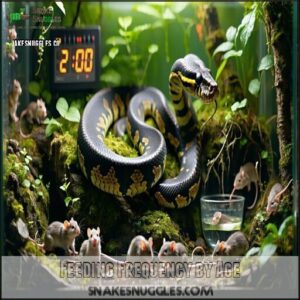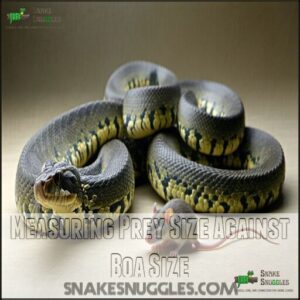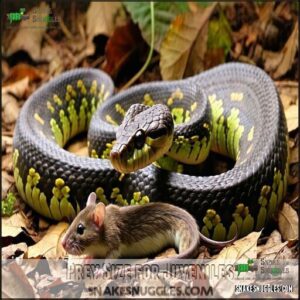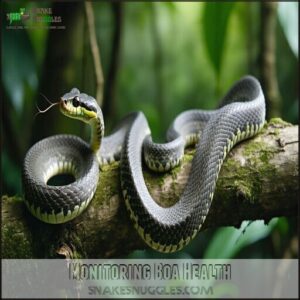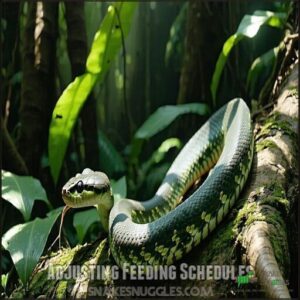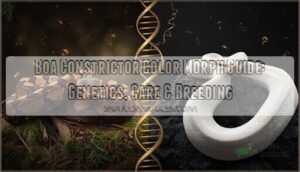This site is supported by our readers. We may earn a commission, at no cost to you, if you purchase through links.
 Boa constrictors eat about every 7 to 14 days, but it depends on their age, size, and activity level.
Boa constrictors eat about every 7 to 14 days, but it depends on their age, size, and activity level.
Younger boas need meals more often—around once a week—since they’re growing fast, while adults can go longer between feedings.
Their slow metabolism means they thrive on fewer, larger meals, so don’t worry if your boa skips a week.
Just make sure the prey size matches your snake’s girth; too big, and it’s trouble.
And remember, boas are individuals—some might act like they’re starving when they’re not, and it’s crucial to keep an eye on their weight and behavior to tweak their schedule as needed.
Table Of Contents
- Key Takeaways
- Boa Constrictor Eating Habits
- How Often Boas Eat
- Feeding Frequency by Age
- Choosing Right Prey Size
- Prey Size for Different Ages
- Feeding Schedule Considerations
- Monitoring Boa Health
- Adjusting Feeding Schedules
- Maintaining Boa Nutrition
- Frequently Asked Questions (FAQs)
- How often do boa constrictors eat?
- How often should I Feed my Boa?
- Can a boa constrictor eat a rabbit?
- How do I set a boa constrictor feeding schedule?
- Do boa constrictors need to be fed?
- How long can a boa constrictor go without eating?
- Can boa constrictors eat other reptiles safely?
- How to handle regurgitation after feeding a boa?
- What signs indicate a boa is stressed?
- Are there risks feeding boas during shedding?
- Conclusion
Key Takeaways
- Younger boas eat more often, around every 5-7 days, while adults eat less frequently, every 3-8 weeks, depending on size and health.
- Always match the prey size to your boa’s girth to ensure proper digestion and avoid health issues.
- Seasonal changes and shedding cycles affect feeding frequency, with boas typically eating less in cooler months or during shedding.
- Maintain a healthy weight by monitoring your boa’s body condition, avoiding overfeeding, and adjusting feeding schedules as needed.
Boa Constrictor Eating Habits
You’ll find that your boa constrictor’s eating patterns can vary dramatically, from once every five days for youngsters to just once every two months for mature adults.
Understanding these feeding requirements will help you keep your snake healthy and prevent the common pitfalls of overfeeding that many new boa owners face.
Factors Affecting Feeding Schedule
Your boa constrictor’s feeding schedule isn’t set in stone.
Several factors influence how often your snake needs to eat, including its individual metabolism, age, size, and overall health.
Temperature impacts digestion substantially—warmer environments speed up metabolism.
Stress can cause feeding refusals, while shedding cycles naturally reduce appetite.
Pay attention to your boa’s weight and feeding habits to determine its unique nutritional needs.
Environmental and Seasonal Factors
Several environmental factors dramatically affect your boa constrictor’s feeding frequency.
Temperature impacts appetite—cooler months slow their metabolism, reducing boa constrictor feeding frequency from once monthly to every 2-3 months.
Cooler months slow metabolism, so your boa may eat as little as once every 2-3 months.
High humidity levels during shedding cycles can trigger feeding refusals.
Seasonal adjustments mimic wild conditions, where barometric pressure changes signal prey availability.
Smart keepers track these environmental patterns, making seasonal feeding adjustments that respect their snake’s natural rhythms.
Individual Snake Needs
Just as the seasons affect your boa’s appetite, your snake’s individual makeup directly influences their eating patterns.
No two boas are exactly alike.
Your boa’s feeding needs vary based on:
- Metabolic rates (some boas burn energy faster than others)
- Activity levels (more active snakes may need more frequent meals)
- Health conditions (illness can suppress appetite)
Understanding your boa constrictor’s unique temperament impact on feeding habits guarantees proper nutrition and weight management.
Captive boas sometimes require dietary supplementation to avoid deficiencies, which is crucial for their overall health.
How Often Boas Eat
Regarding feeding intervals, your boa constrictor’s appetite follows a much different schedule than what most pet owners expect.
Unlike mammals that eat daily, these magnificent reptiles thrive on infrequent meals that align with their slow prey digestion process.
Here’s what every boa owner should know about meal frequency:
- Adult boas typically eat once every 7-10 days, though some may go 3-8 weeks between meals.
- Younger boas require more frequent feeding (every 5-7 days) to support their rapid growth.
- Seasonal variation affects appetite, with many boas eating less during winter months.
- Regular weight monitoring helps determine if your feeding schedule is appropriate.
- Refusing food doesn’t always indicate health problems; boas naturally fast for various reasons.
Your constrictor’s feeding habits may seem shocking at first, but this schedule mimics their natural diet perfectly, and it’s essential to understand that regular weight monitoring is crucial for their health.
It’s also important to note that boas naturally fast, and this behavior should not immediately raise concerns about their health, as it is a part of their natural behavior.
Feeding Frequency by Age
You’ll need to adjust your boa’s meal schedule based on its age, with younger snakes requiring more frequent feedings than their older counterparts.
As your snake grows from a hungry baby eating every 5-7 days to a mature adult dining monthly, you’ll witness the remarkable adaptation of their metabolism to support different life stages.
Newborn and Juvenile Boas
Now that we’ve a grasp of general boa feeding patterns, let’s examine the unique needs of your youngest serpents.
Proper feeding frequency is critical for your newborn and juvenile boas, with significant differences between age groups.
| Age Group | Feeding Frequency | Prey Size | Special Notes |
|---|---|---|---|
| Neonates (0-6 months) | Every 10-12 days | Hopper mice | Wait 1 week after purchase |
| Early Juveniles (6-12 months) | Every 4-7 days | Large mice | Monitor for growth spurts |
| Later Juveniles (1-2 years) | Every 10-14 days | Small rats | Begin prey progression |
| Pre-adults (2-3 years) | Every 2-3 weeks | Medium rats | Establish supplement schedule |
You’ll notice your hatchling’s feeding needs differ dramatically from adults. Most baby boas (99%) readily accept their first meal, but don’t rush it! Allowing proper digestion between feedings prevents health issues while supporting healthy development.
Young Adult and Adult Boas
As your boa matures into young adulthood, its feeding needs change dramatically. Your 1-3 year old snake now requires less frequent meals than when it was a juvenile.
For proper adult boa feeding, follow this schedule:
- Feed young adults (1-3 years) every 10-14 days
- Provide fully mature adults (3+ years) meals every 3-4 weeks
- Increase prey size rather than frequency if your boa seems hungry
- Maintain a "loaf of bread" body shape with flat sides
- Adjust according to seasonal feeding habits (feed more in summer) to ensure your boa’s nutritional needs are met, and remember to feed according to its age and size.
Mature Adult Boas
Your mature adult boa’s metabolism slows dramatically after age 3.
You’ll notice a shift in feeding frequency to every 3-6 weeks, preventing obesity risks while maintaining health.
| Age Group | Feeding Frequency | Prey Size |
|---|---|---|
| 3-5 years | Every 3-4 weeks | Medium/Large rat |
| 5-10 years | Every 4-5 weeks | Large rat |
| 10+ years | Every 5-6 weeks | Large/XL rat |
| Breeding Adults | Winter feeding: reduced | Supplement needs: increased |
The feeding schedule is crucial for the health of your boa, and understanding the feeding frequency is key to preventing health issues.
Choosing Right Prey Size
You’ll need to select prey that’s no larger than the widest part of your boa’s body, typically not exceeding 10% of your snake’s total weight.
Choosing the right prey size guarantees proper digestion and prevents health issues, making your boa’s mealtime both safe and satisfying.
Measuring Prey Size Against Boa Size
Determining the right prey size for your boa constrictor is vital for digestive health.
You’ll want to follow the prey-to-snake ratio of no more than 10% of your boa’s weight. The prey should match the widest part of your boa’s body, creating only a slight lump after feeding.
Knowing the appropriate boa prey is essential for their well-being.
This body width match prevents overfeeding risks while ensuring proper nutrition.
Types of Prey for Boa Constrictors
Now that you’ve correctly measured prey size, let’s look at what your boa can actually eat. Your scaly friend isn’t picky about their menu.
- Rodents (mice and rats) form the backbone of boa constrictor feeding
- Rabbits provide excellent nutrition for larger specimens
- Bird prey might appeal to certain subspecies like B. c. nebulosa
- Reptiles and amphibians occasionally supplement their diet in the wild
Many owners opt for pre-killed frozen rodents for convenience and safety.
Prey Size for Different Ages
You’ll need to match your boa’s meal size to its age, just as you wouldn’t serve a toddler a porterhouse steak.
As your snake grows from a tiny hatchling to a full-sized adult, you’ll gradually increase prey size from small mice to large rats or rabbits, ensuring proper nutrition without overfeeding.
Prey Size for Hatchlings
Now that you’ve selected the right prey size, let’s focus on what works for your tiny newcomers.
Hatchling boa constrictors thrive on small prey like pinky or fuzzy mice.
Initial prey should be no larger than the widest part of your snake’s body.
For ideal nutritional needs, hopper size mice work well, with prey weight staying under 10% of your hatchling’s weight.
This feeding progression guarantees healthy development without digestive issues.
Prey Size for Juveniles
As your hatchling grows into a juvenile boa, you’ll need to level up their menu.
Juveniles (1-3 years old) require prey that matches their increasing size.
- Medium-sized rats work perfectly for most juvenile boas
- Prey weight should stay within 5-10% of your boa’s body weight
- Properly thawed frozen prey prevents digestive issues
- Feed juveniles every 7-10 days to support healthy growth
- Choose mature prey for better nutritional prey value
Boa constrictor newborns exhibit species size variability, influencing their initial prey needs.
Prey Size for Adult Boas
As your juvenile boa grows into adulthood, its prey needs change dramatically.
For adult boas (3+ years), medium to large rats or even small rabbits become the ideal prey.
You’ll want to offer food weighing 7-10% of your boa’s body weight.
A 15-pound adult boa constrictor can handle prey around 1-1.5 pounds, which guarantees proper nutritional content while avoiding digestion issues that come with oversized meals, ensuring the boa’s health and well-being with correct feeding.
Feeding Schedule Considerations
You’ll need to create a feeding schedule that mimics your boa’s natural hunting patterns, with erratic timing that improves feeding response and overall activity.
Watching for hunger cues like increased movement and frequent tongue flicking will help you determine when your snake is ready for its next meal, preventing both overfeeding and unnecessary stress.
Erratic Feeding and Nocturnal Behavior
Now that you understand prey sizing, let’s look at how feeding patterns affect your boa’s behavior.
Mimicking your boa’s natural nocturnal hunting habits creates a healthier captive experience.
Implementing erratic feeding schedules offers four key benefits:
- Stimulates natural hunting instincts
- Prevents predictable feeding dependency
- Encourages more natural activity cycles
- Reduces potential feeding aggression
Try offering varied meals after sunset when your boa constrictor is naturally more alert and receptive to food, which can help create a more natural experience.
Hunger Cues and Feeding Response
Since boas are nocturnal hunters, recognizing their hunger cues is your next skill to master.
Watch for increased activity, frequent prowling behavior, and rapid tongue flicking—these are clear signals your boa is ready to eat.
Always use feeding tongs to prevent your snake from associating your hands with food.
This "tong association" trains your boa constrictor’s feeding response and keeps your fingers safe!
Monitoring Boa Health
You’ll need to check your boa’s body shape regularly to verify it’s maintaining a healthy square form rather than showing ribs or developing fat rolls.
Your snake’s eating habits directly reflect its health, so monitoring weight changes can help you spot potential problems before they become serious, which is crucial for maintaining its overall well-being.
Signs of Healthy Weight
How can you tell if your boa constrictor is at a healthy weight? Look for a square-shaped body with a slight groove down the center of the back.
Your boa should have good muscle tone without visible spine or fat deposits. A healthy body condition score shows no protruding bones and no rolls.
Regular weight monitoring helps track your pet’s health, supporting proper feeding habits that align with natural growth patterns.
Owners should also observe their boa’s eyes for signs of clarity to confirm good health.
Signs of Underweight or Overweight
Spotting weight issues in your boa is simple.
An underweight snake shows a triangular body, visible ribs, and spine visibility, while sagging skin hints at poor muscle tone.
Overweight boas have a rounded shape, fat rolls, and squishy bellies.
A healthy weight looks like a loaf of bread—square-shaped with no fat deposits.
Monitor body condition regularly!
Adjusting Feeding Schedules
You’ve got to adjust your boa’s feeding schedule as it grows, since their needs change with age and size.
Paying attention to their activity and body condition helps you figure out when it’s time for a meal or a longer break, which is crucial for maintaining their overall health.
Adjusting for Age and Size
Adjusting your boa constrictor feeding schedule based on age and size guarantees proper growth and health.
Neonate feeding requires smaller, frequent meals, while juvenile portions gradually increase. Adult frequency slows due to a mature metabolism.
Monitor size progression to match boa constrictor prey size appropriately. Seasonal adjustments may also be necessary for ideal health.
- Neonates: Feed every 5-7 days.
- Juveniles: Every 10-14 days.
- Adults: Every 3-4 weeks.
- Match prey size to boa’s width.
- Avoid overfeeding; obesity risks rise.
Adjusting for Individual Needs
Not all boas follow the same feeding schedule. Their metabolic rate, activity levels, temperament, health conditions, and breeding status can impact feeding frequency.
Keep an eye on your boa’s weight and behavior to adjust meals as needed. A personalized plan guarantees a healthy boa constrictor metabolism and feeding habits.
| Factor | Impact on Feeding | Adjustment Needed | Example |
|---|---|---|---|
| Metabolic Rate | Faster metabolism | More frequent feeding | Young boas need weekly meals. |
| Activity Levels | Higher activity | Increase food intake | Active boas burn more energy. |
| Temperament Impact | Stress or aggression | Smaller, spaced meals | Calmer boas eat less often. |
| Health Conditions | Illness or obesity | Consult a vet | Obese boas need less food. |
The factors influencing feeding schedules include health conditions, activity levels, and temperament impact. Understanding these factors is crucial for creating an effective feeding plan for your boa constrictor.
Maintaining Boa Nutrition
You’ve got to balance your boa’s meals carefully to keep it healthy and thriving. Providing fresh water and avoiding overfeeding or underfeeding are key to maintaining proper nutrition.
Importance of Fresh Water
Don’t overlook fresh water—it’s as essential as feeding.
Boa constrictor care includes keeping a clean water bowl available at all times. Hydration aids shedding, regulates temperature, and supports waste elimination.
Without it, their overall health suffers. Imagine skipping water for days—your boa feels that too!
Replace water daily to guarantee it’s fresh, keeping your snake happy and thriving.
A proper habitat should include a suitable water dish for hydration.
Preventing Overfeeding and Underfeeding
While keeping fresh water available, don’t overlook the importance of a consistent schedule for feeding.
Overfeeding can lead to obesity, while underfeeding impacts growth.
Use a feeding log to track prey weight limits and feeding frequency.
Monitor the Body Condition Score—healthy boas appear rounded, not fat or thin.
If unsure about your boa constrictor feeding schedule, seek veterinary consultation.
Frequently Asked Questions (FAQs)
How often do boa constrictors eat?
Think of feeding a boa constrictor like scheduling a gourmet meal plan.
Babies eat every 5-7 days, juveniles every 7-14 days, and adults every 3-8 weeks.
Frequency depends on age, size, and health.
How often should I Feed my Boa?
Feed your boa based on its age and size—babies every 5-7 days, juveniles every 10-14 days, and adults every 3-4 weeks.
Stick to a schedule, but watch for hunger cues like prowling.
Can a boa constrictor eat a rabbit?
A boa constrictor can eat a rabbit if it’s appropriately sized—no larger than the snake’s widest part.
Adult boas often enjoy rabbits as a hearty meal, but overfeeding risks obesity, so balance is key!
How do I set a boa constrictor feeding schedule?
Set your boa’s feeding schedule based on its age and size.
Younger boas eat every 5-7 days, while adults eat every 3-4 weeks.
Monitor body condition, adjust as needed, and track meals consistently.
Do boa constrictors need to be fed?
Yes, they do!
Boa constrictors need regular meals to stay healthy, but their feeding frequency depends on age and size.
Stick to frozen-thawed prey and adjust schedules based on their activity and body condition.
How long can a boa constrictor go without eating?
Some boas can go months without eating, but it’s not ideal.
They’re built to survive feast or famine, but skipping meals for too long risks health.
Pay attention to body condition—no spine, no fat rolls!
Can boa constrictors eat other reptiles safely?
Feeding other reptiles to a boa constrictor isn’t ideal.
It can expose them to parasites or diseases.
Stick to frozen-thawed rodents—they’re safer, more nutritious, and easier to digest.
Keep your boa’s diet simple and stress-free!
How to handle regurgitation after feeding a boa?
Imagine your boa just hit "undo" on its meal—wait 7-10 days before feeding again.
Keep stress low, check enclosure temps, and consult a vet if regurgitation keeps happening.
Patience helps avoid making things worse!
What signs indicate a boa is stressed?
Stress in boas shows as hiding for long periods, striking defensively, refusing food, or regurgitating after meals.
You might also notice excessive tongue flicking or restlessness.
Addressing changes in their habitat often helps to alleviate stress and improve the boa’s behavior, particularly by reducing defensively striking.
Are there risks feeding boas during shedding?
Over 85% of boa owners notice reduced feeding interest during shedding.
It’s risky to feed now since digestion slows, stress spikes, and prey might be regurgitated.
Waiting guarantees smoother shedding and a happier snake!
Conclusion
Feeding a boa constrictor isn’t as simple as it sounds.
Their unique metabolism and individual needs make the question of how often a boa constrictor eats more nuanced than expected.
Younger boas need weekly meals, while adults can wait 10-14 days.
Always match prey size to their girth, monitor their weight, and adjust schedules for health and activity levels.
With the right care, you’ll keep your boa happy, healthy, and thriving—no guesswork required.
- https://community.morphmarket.com/t/feeding-question/38842
- https://www.reptileforums.co.uk/threads/how-often-do-you-feed-adult-boas.1013149/
- https://www.animalsathome.ca/boa-constrictor-feeding-chart/
- https://reptifiles.com/boa-constrictor-care/what-do-boa-constrictors-eat/
- https://www.cdc.gov/nutrition/infantandtoddlernutrition/breastfeeding/how-much-and-how-often.html



